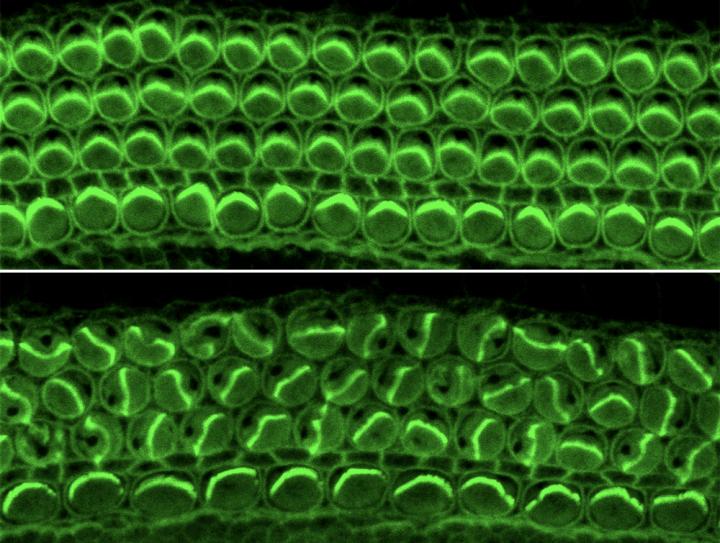New images reveal how the ear's sensory hairs take shape

To pick up these sounds, tiny hair-like filaments in the inner ear must be packed into precisely arranged bundles, all facing the same direction (top). Researchers identified a protein essential to this process. Credit: Laboratory of Sensory Neuroscience at The Rockefeller University Usage Restrictions: Image may be used only to illustrate the research described in the accompanying release.
Scientists already knew that a molecular blueprint guides the formation of upside-down V-shaped bundles on the surface of inner ear cells that detect sound, motion, and spatial orientation.
While investigating how cells draw up these blueprints, Kimberly Siletti, a graduate student in the lab, found evidence implicating a protein called Daple. It was already known to interact with a so-called compass structure, ensuring that the V-shape bundles are aligned properly to catch sound propagating through the cochlea.
Understanding these molecular orientation systems is critical because if disrupted the bundles grow facing the wrong direction, sometimes even backward. For the bundle to develop properly, the blueprint and the compass must work together.
“These two systems were discovered independently, and it isn't clear how they are coordinated,” Siletti says. “Our experiments suggest that Daple is part of the molecular machinery that links them.”
To test this hypothesis, the researchers switched off the protein in mice. The effect of this manipulation, captured in high-resolution, was conspicuous: the hair cells of animals that lacked the protein developed scrambled bundles without the distinctive V-shape (bottom image).
The scientists think Daple influences the shape of the hair bundles indirectly, by determining the position of the first filament to emerge at what becomes the apex of each bundle. If that filament is positioned improperly, the blueprint becomes warped. Their work was described in the Proceedings of the National Academy of Sciences.
Media Contact
All latest news from the category: Life Sciences and Chemistry
Articles and reports from the Life Sciences and chemistry area deal with applied and basic research into modern biology, chemistry and human medicine.
Valuable information can be found on a range of life sciences fields including bacteriology, biochemistry, bionics, bioinformatics, biophysics, biotechnology, genetics, geobotany, human biology, marine biology, microbiology, molecular biology, cellular biology, zoology, bioinorganic chemistry, microchemistry and environmental chemistry.
Newest articles

Trotting robots reveal emergence of animal gait transitions
A four-legged robot trained with machine learning by EPFL researchers has learned to avoid falls by spontaneously switching between walking, trotting, and pronking – a milestone for roboticists as well…

Innovation promises to prevent power pole-top fires
Engineers in Australia have found a new way to make power-pole insulators resistant to fire and electrical sparking, promising to prevent dangerous pole-top fires and reduce blackouts. Pole-top fires pose…

Possible alternative to antibiotics produced by bacteria
Antibacterial substance from staphylococci discovered with new mechanism of action against natural competitors. Many bacteria produce substances to gain an advantage over competitors in their highly competitive natural environment. Researchers…





















